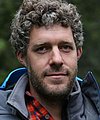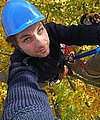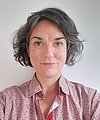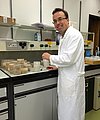The Ukrainian Carpathians harbor still more than 200 km2 (20’000 hectares) of primeval forests, most of them are within the Carpathian Biosphere Reserve (CBR). An outstanding example of such a forest undisturbed by man is the primeval forest of Uholka-Shyrokyi Luh (approx. 100 km2), which was inscribed to the UNESCO World Natural Heritage List in 2007, together with some other primeval forest relicts in Slovakia and Ukraine.
Contents ¶



Beech forests are among the most important forest types of Switzerland. Their structure and biological diversity have been altered, however, by centuries of intensive forest management. Primeval beech forests do not exist anymore in Switzerland. The primeval forests of the Carpathians, which are similar to many forests in Switzerland with regards to tree species composition and growth conditions, are therefore of high interest to WSL as research and reference objects.
The WSL has been collaborating with the CBR and other Ukrainian research institutes and universities since 1999. The general aims of this research cooperation are:
- to network experts and to encourage collaboration and scientific exchange in the field of primeval forest and biodiversity research;
- to carry out joint research projects to obtain new insights into the structures, dynamics and diversity of natural ecosystems undisturbed by man;
- to harmonize research and inventory methods to facilitate the exchange and comparability of data and results;
- to strengthen the mid-level academic staff and promote young researchers;
- to raise publicity and awareness of the Ukrainian primeval forests to ensure their long-term protection;
- to foster a sustainable, nature-oriented forest management.
Cooperation project with Ukrainian forest research institutes ¶
With the support of the State Secretary for Education, Research and Innovation SERI, WSL was able to launch a new project with Ukrainian forest research institutions which will last until 2024. The project builds on the successful collaboration between Swiss and Ukrainian researchers since 1999. It focuses on issues regarding primeval forest research, where the unique primeval beech forest Uholka-Shyroki Luh is the focal point, but also incorporates research into the use of sustainable resources. The project will once again enable an intensive exchange between Swiss and Ukrainian researchers.
Partners
- Carpathian Biosphere Reserve (CBR), Rakhiv
- Ukrainian National Forestry University (UNFU), Lviv
- Ukrainian Research Institute for Mountain Forestry (URIMF), Ivano-Frankivsk
- Uzhgorod State University, Biological Department
- M.G. Kholodny Institute of Botany National Academy of Sciences of Ukraine
- Institute of Ecology of the Carpathians, Lviv
Financial support
2021-2024: State Secretariat for Education, Research and Innovation SERI
2017-2020: State Secretariat for Education, Research and Innovation SERI
2008-2012: State Secretariat for Education, Research and Innovation SERI
2005-2008: Swiss National Science Foundation SNFS (SCOPES Institutional Partnership IB74A0-111087)
2002-2003: Swiss National Science Foundation SNFS (SCOPES Institutional Partnership 7IP 062590)
2000-2003: Velux Foundation
Projekt Team ¶
- Prof. Dr. T. Lachat, School of Agricultural, Forest and Food Science HAFL, Zollikofen
- Prof. Dr. J. Blaser, School of Agricultural, Forest and Food Science HAFL, Zollikofen
Partners ¶
Swiss partners:
- Centre for Development and Environment, CDE, Bern: Dr. Heino Meessen
- University of Bern, Institute of History, Eastern European History, Bern: Prof. Dr. Julia Richers
Ukrainian partners:
- Ukrainian National Forestry University (UNFU), Lviv: Prof. and Vice-Rector Vasyl Lavnyy, Lecturer Mykola Korol, Lecturer Dr. Lyudmyla Maksymiv, Ihor Soloviy
- University of Ivano-Frankivsk: Lecturer Yuriy Shparyk
- Carpathian Biosphere Reserve (CBR), Rakhiv: Prof. Fedir Hamor, Mykola Rybak, Myroslav Kabal, Ruslan Hleb, Vasyl Pokynchereda
- FORZA, Agency for Sustainable Development of the Carpathian Region, Uzhgorod Lesya Loyko, Radmila Ustych, Nataliya Voloshyna
- National University of Live and Environmental Sciences of Ukraine, Kiev: Prof. Ivan Lakyda
- State Museum of Natural History, National Academy of Sciences of Ukraine, Lviv: Dr. Volodymyr Rizun
- Uzhhorod National University, Lecturer Dr. Maxym Chumak
Publications ¶
Portier J., Shackleton R.T., Klesse S., Ferretti M., Flury R., Hobi M.L., … Thürig E. (2024) No evidence that coring affects tree growth or mortality in three common European temperate forest tree species. Eur. J. For. Res. 143, 129-139. https://doi.org/10.1007/s10342-023-01612-6 Institutional Repository DORA
Käber Y., Bigler C., HilleRisLambers J., Hobi M., Nagel T.A., Aakala T., … Bugmann H. (2023) Sheltered or suppressed? Tree regeneration in unmanaged European forests. J. Ecol. 111(10), 2281-2295. https://doi.org/10.1111/1365-2745.14181 Institutional Repository DORA
Petrovska R., Bugmann H., Hobi M.L., Brang P. (2023) Replace me if you can: abundance of advance regeneration under canopy trees in a primeval beech forest. For. Ecol. Manag. 537, 120939 (12 pp.). https://doi.org/10.1016/j.foreco.2023.120939Institutional Repository DORA
Swiss Federal Research Institute WSL (Ed.) (2019) Temperate and boreal primeval forests in the face of global change. Program and abstracts. Temperate and boreal primeval forests in the face of global change conference. Birmensdorf: Swiss Federal Research Institute WSL. 137 p. Institutional Repository DORA
Larrieu L., Courbaud B., Drénou C., Goulard M., Bütler R., Kozák D., … Vandekerkhove K. (2022) Key factors determining the presence of Tree-related Microhabitats: a synthesis of potential factors at site, stand and tree scales, with perspectives for further research. For. Ecol. Manag. 515, 120235 (12 pp.). https://doi.org/10.1016/j.foreco.2022.120235Institutional Repository DORA
Stillhard J., Abegg M., Brang P., Hobi M. (2022) Entwicklung im Buchenurwald Uholka-Schyrokyi Luh über 9 Jahre. Bündnerwald. 75(1), 18-21. Institutional Repository DORA
Brändli U.B., Abegg M., Düggelin C., Traub B. (2021) Baummikrohabitate im Schweizer Wald und im Buchenurwald Uholka-Schyrokyj Luh. Schweiz. Z. Forstwes. 172(5), 286-299. https://doi.org/10.3188/szf.2021.0286 Institutional Repository DORA
Petrovska R., Bugmann H., Hobi M.L., Ghosh S., Brang P. (2022) Survival time and mortality rate of regeneration in the deep shade of a primeval beech forest. Eur. J. For. Res. 141, 43-58. https://doi.org/10.1007/s10342-021-01427-3 Institutional Repository DORA
Stillhard J., Hobi M.L., Brang P., Brändli U.B., Korol M., Pokynchereda V., Abegg M. (2022) Structural changes in a primeval beech forest at the landscape scale. For. Ecol. Manag. 504, 119836 (12 pp.). https://doi.org/10.1016/j.foreco.2021.119836Institutional Repository DORA
Courbaud B., Larrieu L., Kozak D., Kraus D., Lachat T., Ladet S., … Zudin S. (2022) Factors influencing the rate of formation of tree‐related microhabitats and implications for biodiversity conservation and forest management. J. Appl. Ecol. 59(2), 492-503. https://doi.org/10.1111/1365-2664.14068 Institutional Repository DORA
Sabatini F.M., Bluhm H., Kun Z., Aksenov D., Atauri J.A., Buchwald E., … Kuemmerle T. (2021) European primary forest database v2.0. Sci. Data. 8, 220 (14 pp.). https://doi.org/10.1038/s41597-021-00988-7Institutional Repository DORA
Petrovska R., Brang P., Gessler A., Bugmann H., Hobi M.L. (2021) Grow slowly, persist, dominate—Explaining beech dominance in a primeval forest. Ecol. Evol. 11(15), 10077-10089. https://doi.org/10.1002/ece3.7800 Institutional Repository DORA
Zhong Y., Chu C., Myers J.A., Gilbert G.S., Lutz J.A., Stillhard J., … Zimmerman J.K. (2021) Arbuscular mycorrhizal trees influence the latitudinal beta-diversity gradient of tree communities in forests worldwide. Nat. Commun. 12, 3137 (12 pp.). https://doi.org/10.1038/s41467-021-23236-3Institutional Repository DORA
Larrieu L., Cabanettes A., Courbaud B., Goulard M., Heintz W., Kozák D., … Svoboda M. (2021) Co-occurrence patterns of tree-related microhabitats: a method to simplify routine monitoring. Ecol. Indic. 127, 107757 (10 pp.). https://doi.org/10.1016/j.ecolind.2021.107757Institutional Repository DORA
Stillhard J., Abegg M., Keller S., Düggelin C., Brändli U.B. (2019) Stichprobeninventur im Buchenurwald Uholka-Schyrokyj Luh. Anleitung für die zweite Inventur 2019. Birmensdorf, Switzerland: Eidgenössische Forschungsanstalt für Wald, Schnee und Landschaft. 68 p. Institutional Repository DORA
Sabatini F.M., Keeton W.S., Lindner M., Svoboda M., Verkerk P.J., Bauhus J., … Kuemmerle T. (2020) Protection gaps and restoration opportunities for primary forests in Europe. Divers. Distrib. 26(12), 1646-1662. https://doi.org/10.1111/ddi.13158 Institutional Repository DORA
Gossner M.M., Gazzea E., Diedus V., Jonker M., Yaremchuk M. (2020) Using sentinel prey to assess predation pressure from terrestrial predators in water-filled tree holes. Eur. J. Entomol. 117, 226-234. https://doi.org/10.14411/eje.2020.024 Institutional Repository DORA
Stiers M., Willim K., Seidel D., Ammer C., Kabal M., Stillhard J., Annighöfer P. (2019) Analyzing spatial distribution patterns of European Beech (Fagus sylvatica L.) regeneration in dependence of Canopy Openings. Forests. 10(8), 637 (20 pp.). https://doi.org/10.3390/f10080637Institutional Repository DORA
Stillhard J., Hobi M., Hülsmann L., Brang P., Ginzler C., Kabal M., … Commarmot B. (2019) Stand inventory data from the 10‐ha forest research plot in Uholka: 15 yr of primeval beech forest development. Ecology. 100(11), e02845 (1 pp.). https://doi.org/10.1002/ecy.2845Institutional Repository DORA
Soloviy I., Melnykovych M., Björnsen Gurung A., Hewitt R.J., Ustych R., Maksymiv L., … Kaflyk M. (2019) Innovation in the use of wood energy in the Ukrainian Carpathians: opportunities and threats for rural communities. For. Policy Econ. 104, 160-169. https://doi.org/10.1016/j.forpol.2019.05.001 Institutional Repository DORA
Willim K., Stiers M., Annighöfer P., Ammer C., Ehbrecht M., Kabal M., … Seidel D. (2019) Assessing understory complexity in beech-dominated forests (Fagus sylvatica L.) in Central Europe — from managed to primary forests. Sensors. 19(7), 1684 (13 pp.). https://doi.org/10.3390/s19071684Institutional Repository DORA
Zierl B. (2014) Urwaldforschung in der Ukraine: Satellitenbilder eröffnen neue Perspektiven. WSL-Mag. Diagonal. (1), 23. Institutional Repository DORA
Zierl B. (2014) Recherche sur la forêt primaire en Ukraine: des photos satellite ouvrent de nouvelles perspectives. Mag. WSL Diagonale. (1), 23. Institutional Repository DORA
Lachat T., Chumak M., Chumak V., Jakoby O., Müller J., Tanadini M., Wermelinger B. (2016) Influence of canopy gaps on saproxylic beetles in primeval beech forests: a case study from the Uholka-Shyrokyi Luh forest, Ukraine. Insect Conserv. Divers. 9(6), 559-573. https://doi.org/10.1111/icad.12188 Institutional Repository DORA
Böni R., Seidl I., Junge X. (2014) Produits d'alpage: entre tradition et nouveautés. In S. Lauber, F. Herzog, I. Seidl, R. Böni, M. Bürgi, P. Gmür, … R. Wunderli (Eds.), Avenir de l'économie alpestre suisse. Faits, analyses et pistes de réflexion du programme de recherche AlpFUTUR. Birmensdorf; Zurich-Reckenholz: WSL; Agroscope. 94-109. Institutional Repository DORA
Nadyeina O.V. (2013) Епіфітно-епіксильні види роду Rinodina (Ach.) Gray з Physcia-типом спор в Україні. The epiphytic-epixylic species of the genus Rinodina (Ach.) Gray with Physica-spores in Ukraine. Chornomorski Bot. J. 9(2), 265-274. Institutional Repository DORA
Trotsiuk V., Hobi M.L., Commarmot B. (2012) Age structure and disturbance dynamics of the relic virgin beech forest Uholka (Ukrainian Carpathians). For. Ecol. Manag. 265, 181-190. https://doi.org/10.1016/j.foreco.2011.10.042Institutional Repository DORA
Chumak V., Obrist M.K., Moretti M., Duelli P. (2015) Arthropod diversity in pristine vs. managed beech forests in Transcarpathia (Western Ukraine). Glob. Ecol. Conserv. 3, 72-82. https://doi.org/10.1016/j.gecco.2014.11.001Institutional Repository DORA
Hobi M.L., Ginzler C., Commarmot B., Bugmann H. (2015) Gap pattern of the largest primeval beech forest of Europe revealed by remote sensing. Ecosphere. 6(5), 76 (15 pp.). https://doi.org/10.1890/ES14-00390.1Institutional Repository DORA
Commarmot B., Shparyk Y., Sukharyuk D., Bürgi A., Zingg A. (2009) Entwicklung zum Urwald? Ein Vergleich zwischen dem Zürcher Sihlwald und dem Buchenurwald Uholka in der Westukraine. In V. Grundmann (Ed.), Mitteilungen der Hessischen Landesforstverwaltung: Vol. 47. 2. Hessisches Naturwaldforum Buche. 28.-29. April 2008 in Bad Wildungen. Wiesbaden; Kassel: Hessisches Ministerium für Umwelt, Energie, Landwirtschaft und Verbraucherschutz; Landesbetrieb Hessen-Forst. 42-48. Institutional Repository DORA
Bachofen H. (2004) Die Stammzahlverteilung im Jungwuchs unter Buchenaltbeständen. Vergleich eines naturnahen Buchenbestandes im Sihlwald, Schweiz mit einem Bestand im Buchenurwald Uholka, Ukraine. In J. Nagel (Ed.), Deutscher Verband Forstlicher Forschungsanstalten. Sektion Ertragskunde: Beiträge zur Jahrestagung 2004. sine loco: Deutscher Verband Forstlicher Forschungsanstalten Sektion Ertragskunde. 149-156. Institutional Repository DORA
Sukhomlyn M.M. (1999) Distribution of Heterobasidion annosum in Ukraine. In B. Forster, M. Knížek, & W. Grodzki (Eds.), Methodology of forest insect and disease survey in Central Europe. Proceedings of the second workshop of the IUFRO working party 7.03.10. April 20-23, 1999, Sion-Châteauneuf, Switzerland. Birmensdorf, Switzerland: Swiss Federal Institute for Forest, Snow and Landscape Research. 211-214. Institutional Repository DORA
Brändli U.B., Dowhanytsch J., Eidgenössische Forschungsanstalt für Wald, Schnee und Landschaft (Eds.) (2003) Pralisy w zentri Jewropy. Putiwnyk po lisakh Karpatsjkogo biosfernogo sapowidnyka. Urwälder im Zentrum Europas. Ein Naturführer durch das Karpaten-Biosphärenreservat in der Ukraine. [Ukrainische Version]. Bern: Haupt. 192 p. Institutional Repository DORA
Brändli U.B., Dowhanytsch J., Eidgenössische Forschungsanstalt für Wald, Schnee und Landschaft (Eds.) (2003) Urwälder im Zentrum Europas: ein Naturführer durch das Karpaten-Biosphärenreservat in der Ukraine. Bern: Haupt. 192 p. Institutional Repository DORA
Brändli U.B., Dovhanych Y., Commarmot B. (2008) Virgin forest of Uholka. Nature guide to the largest virgin beech forest of Europe. A UNESCO World Heritage site. Birmensdorf; Rakhiv: Swiss Federal Research Institute WSL; Carpathian Biosphere Reserve. 20 p. Institutional Repository DORA
Wallner A. (2005) Biosphärenreservate aus der Sicht der Lokalbevölkerung. Schweiz und Ukraine im Vergleich. Birmensdorf: Eidgenössische Forschungsanstalt für Wald, Schnee und Landschaft WSL. 168 p. Institutional Repository DORA
Commarmot B., Tinner R., Brang P., Brändli U.B. (2010) Stichprobeninventur im Buchen-Urwald Uholka-Schyrokyj Luh – Anleitung für die Inventur 2010. Birmensdorf: Eidg. Forschungsanstalt für Wald, Schnee und Landschaft WSL. 65 p. Institutional Repository DORA
Tsykun T., Rigling D., Nikolaychuk V.I., Prospero S. (2010) Identification and characterization of Armillaria tabescens from the Transcarpathia of Ukraine. Sci. Bull. Uzhgorod Univ. Ser. Biol. 29, 195-203. Institutional Repository DORA
Küffer N., Lovas P.S., Senn-Irlet B. (2004) Diversity of wood-inhabiting fungi in natural beech forests in Transcarpathia (Ukraine): a preliminary survey. Mycol. Balc. 1, 129-134. https://doi.org/10.5281/zenodo.2546727 Institutional Repository DORA
Wallner A., Bauer N., Hunziker M. (2007) Perceptions and evaluations of biosphere reserves by local residents in Switzerland and Ukraine. Landsc. Urban Plan. 83(2-3), 104-114. https://doi.org/10.1016/j.landurbplan.2007.03.006 Institutional Repository DORA
Bachofen H. (2005) Der Einfluss von Aufnahmefehlern und Wachstumsvorgängen auf die Stammzahlverteilung in Buchennaturverjüngungen unter Altholzschirm. Vergleich eines naturnahen Buchenbestandes im Sihlwald, Schweiz, mit einem Bestand im Buchen-Urwald Uholka, Ukraine. Schweiz. Z. Forstwes. 156(10), 365-371. https://doi.org/10.3188/szf.2005.0365 Institutional Repository DORA
Commarmot B., Bachofen H., Bundziak Y., Bürgi A., Ramp B., Shparyk Y., … Zingg A. (2005) Structure of virgin and managed beech forests in Uholka (Ukraine) and Sihlwald (Switzerland): a comparative study. For. Snow Landsc. Res. 79(1-2), 45-56. Institutional Repository DORA
Kondratyuk S.K., Navrotskaya I.L. (1995) Lichens of protected areas in Ukraine. In C. Scheidegger, P. A. Wolseley, & G. Thor (Eds.), Mitteilungen der Eidgenössischen Forschungsanstalt für Wald, Schnee und Landschaft: Vol. 70/1. Conservation biology of lichenised fungi. Birmensdorf: Eidgenössische Forschungsanstalt für Wald, Schnee und Landschaft. 153-156. Institutional Repository DORA














